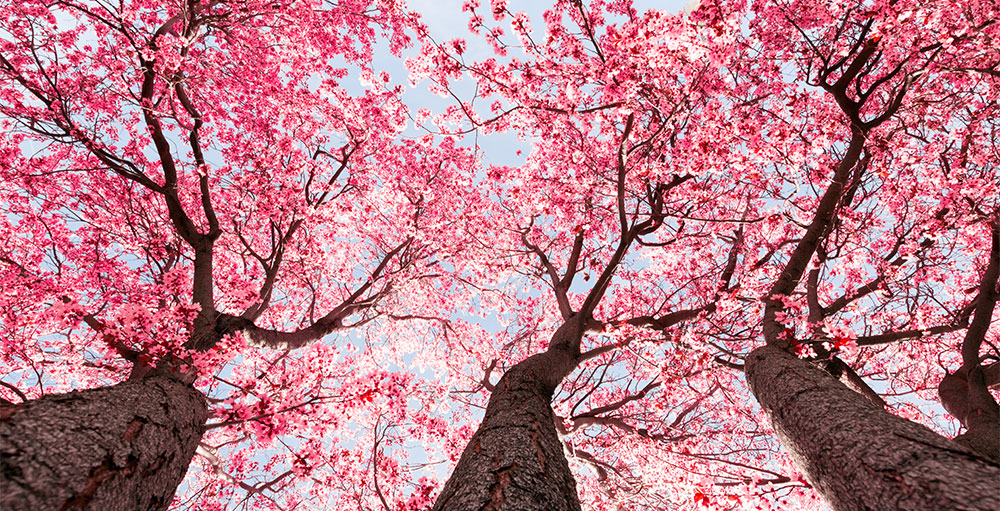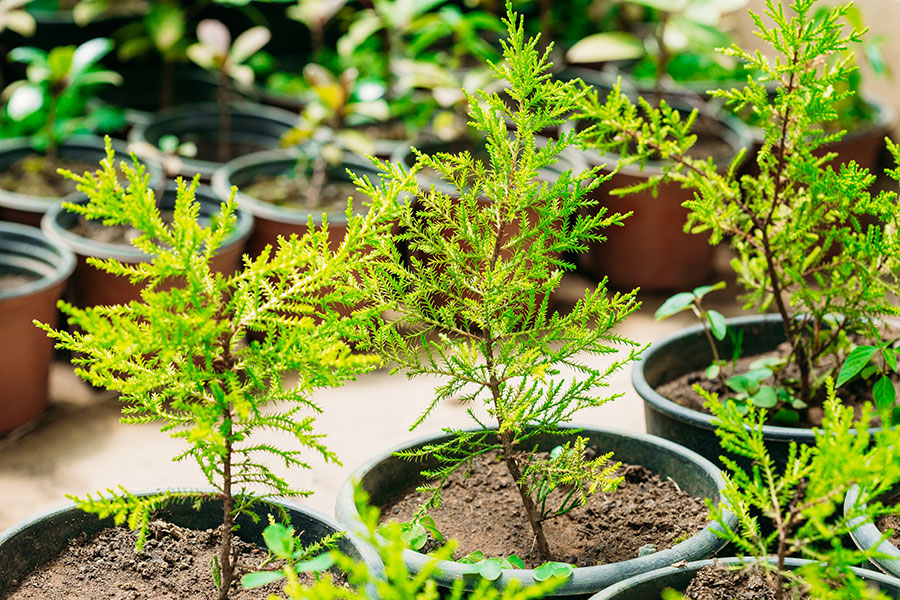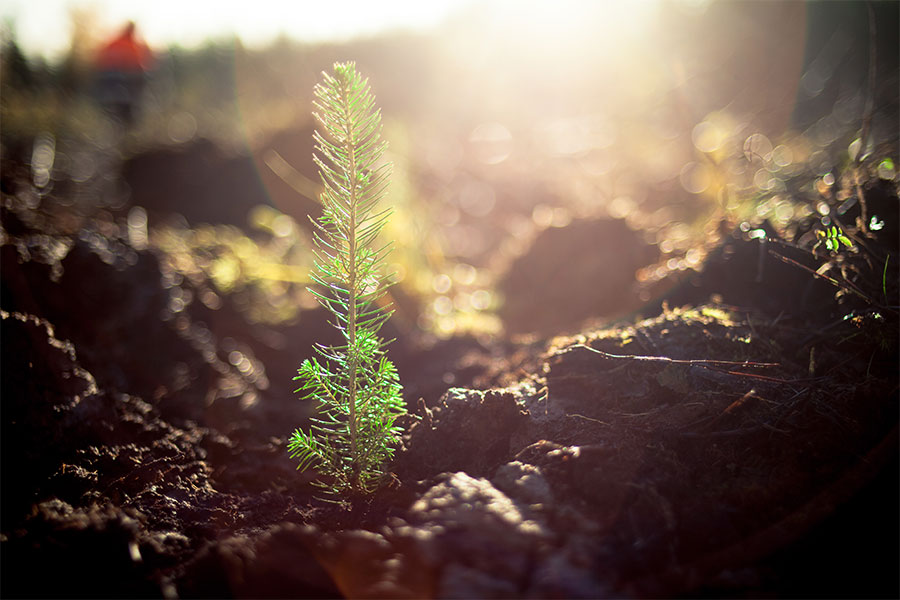Monthly Archives:
Fertilizing Your Trees – The Basics
If you’ve ever dug into the forest floor, you’ve probably observed that the soil looks quite different than the dirt in your backyard.
That’s partly due to the large amounts of organic matter on the surface, and partly because the plentiful organisms in the soil break down that organic matter and incorporate it back into the soil.
Trees growing in the forest thrive without fertilizer because the rich soil gives them all the nutrients they need.
Why Fertilize?
Trees growing in their natural habitats rarely have nutrient deficiencies. In urban settings, however, this is not the case.
Soils in artificial habitats can be very different than native habitats, and they are often lacking in essential nutrients.
If you haven’t fed your trees this year, they may be hungry! Applying fertilizer at least once a year is usually necessary to replenish essential minerals and nutrients in the soil.
When to Fertilize
Although you can’t see them, a tree’s roots continue to take in nutrients well after it sheds its leaves for the year.
A good rule of thumb is to feed your trees in the fall, before it freezes. This way the fertilizer will be absorbed by the roots and ready to feed the tree once it begins to come out of dormancy in the spring. Nutrients at-the-ready allow for robust new growth as leaves emerge.
If fertilizing in the fall is not possible, you can also feed your trees in early spring, as soon as the ground thaws.
Types of Fertilizer
There are many different types of fertilizer; the type you use will depend on your trees, your landscape, and soil conditions.
Granular Fertilizer is applied at the soil’s surface either by hand or by the mechanical spreader. This is often the method of choice for homeowners because it is fast, easy, inexpensive and quite effective. This method is particularly beneficial for trees growing in mulched areas and lawns.
Liquid Injection Fertilizer involves high-pressure injection of liquid fertilizer, allowing for rapid uptake of nutrients, and is often the preferred method of professional arborists.
Fertilizer Spikes or stakes are less common today, as they have shown limited effectiveness. With this method, solid spikes of fertilizer are driven into the soil around trees at measured distances.
Foliar Spray is commonly used as a quick fix for nutrient deficiencies. With foliar feeding, liquid fertilizer is sprayed directly onto the tree’s leaves. Foliar fertilization is a helpful supplemental fertilizer, adding micronutrients just before the growth period, but it is not effective as the only source of fertilizer.
Tree Trunk Injections are primarily used to treat specific mineral deficiencies, such as iron or zinc deficiencies, and are not recommended as general, multi-purpose fertilizer.
What do the Numbers Mean?
On just about every bag of fertilizer, you’ll find, you will see three numbers. The first number indicates the percentage of nitrogen; the second number indicates the percentage of phosphorus, and the third number indicates the percentage of potassium.
These numbers are important because different plants need different ratios of these elements to stay healthy. Research has shown that high nitrogen fertilizers yield the greatest growth in woody plants, such as trees and shrubs.
Pay attention to the ratios, not just the numbers. Look for a high-nitrogen fertilizer with ratios of 3-1-1, 3-1-2 or 4-1-1. For example, an 8-2-2 fertilizer follows the 4-1-1 ratio.
Ask your local arborist or nursery for the best combination for your soil and region.
Slow-release nitrogen fertilizers are best for long-term growth because they allow for nutrient absorption throughout the season, and therefore more uniform growth.
Be careful to avoid lawn fertilizers containing herbicides, which can damage or even kill your trees.
When it comes to tree health, preventive maintenance is key. A vigorous and healthy tree is much less susceptible to disease and infestation.
With proper maintenance, your trees can add value to the landscape and stay healthy for a long time.
How to Keep Your Trees Healthy During Drought
We all know that trees need water to survive, but many homeowners don’t know that watering properly can mean the difference between a tree’s life and death during seasons of drought.
Summer’s heat can take its toll even on established trees. Since trees are difficult and expensive to remove, it’s important to know when your trees are stressed, and how to manage it.
Signs of Heat Stress
Trees are amazingly resourceful and some can survive for a long time in poor conditions with little water. A tree can be suffering silently for years before it finally succumbs.
If your tree shows any of these signs, it may be crying out for help:
- Wilting Leaves
- Premature Leaf Drop
- Yellowing Leaves or Early Fall Foliage
- Sparse Canopy
- Undersized Leaves or Fruit
Trees that are stressed are much more likely to be attacked by insects and diseases, so it’s not uncommon for trees with one of the above symptoms to also be infested.
Caring for Trees During Drought
Follow these tips to keep your trees happy, even when water is scarce:
Mulch
Mulch truly is a tree’s best friend. Not only does mulch reduce evaporation and retain soil moisture, but it also helps regulate soil temperature. Mulch can be a lifesaver in the heat of a summer day, when evaporation is at its peak and the soil dries out more quickly than roots can take in the moisture.
Check the Soil
The best way to tell if your trees need water is simply by testing the soil. Insert a garden trowel about 2 inches into the soil and feel it; if the soil is dry, your tree needs water. Keep in mind, you want the soil to be moist to the touch, not soggy.
Water Slow and Deep
The most important aspect of watering your trees isn’t how much water to give them, it is how to water them. Trees like to be watered slow and deep. Remember, tree roots can extend up to four times beyond the canopy, so don’t just water at the base of the tree.
A drip irrigation system placed beyond the canopy line will allow the tree’s critical root zone to take up water before it’s lost to evaporation. Water to a depth of 10-12 inches, since approximately 90% of a tree’s roots are found within the top 12 inches of soil.
Fertilize
Fertilizing year round will make for stronger, healthier trees that will be tough enough to better withstand periods of drought.
Manage Evaporation
Did you know — during the heat of a summer day, up to 60% of water evaporates before it soaks into the ground? Knowing how to minimize water loss from evaporation is especially critical during times of drought when watering is often restricted and every drop counts. Using a drip line and watering first thing in the morning are effective ways to manage evaporation.
Water Throughout the Year
Trees that are taken care of throughout the year are more resilient when adversity comes. Watering your trees in the winter, as well as the summer, helps them develop strong root systems and encourages healthy growth.
6 Tell-Tale Signs Your Tree Needs To Be Removed
Tree removal isn’t fun or easy, but sometimes it’s necessary. When disease control or pruning is not enough, tree removal may be needed to prevent hazardous situations for people and property.
The Secret Life of Trees
Some trees have a special knack for looking fine on the outside while silently suffering on the inside. To the untrained eye, your tree may look like it’s growing well, but it could actually be crying out for help. A tree can struggle on for years and years before finally succumbing to tree failure, potentially causing injury or destruction as it falls.
The good news is, you can usually tell when a tree needs to be removed if you know what to look for.
Signs Your Tree Should Be Removed
When inspecting your trees, it’s easiest to start at the top and work your way down. If you’ve said yes to one or more of the below questions, contact one of the Friendly Tree experts to assess your tree before it becomes a hazard.
Are there dead or dying branches in the tree’s crown? Crown dieback is usually a symptom of tree stress and large, dead branches can seriously injure those below.
Is the tree suddenly leaning to one side? Some trees naturally lean to one side, but if your tree suddenly starts leaning, this could indicate a structural problem.
Are the tree’s branches growing close to power lines or structures? Proper planning can usually prevent situations like this, but as they say — hindsight is 20/20. When a tree gets too close to power lines, it can quickly become a hazard and should be evaluated by a professional. Homes or other structures built too close to a tree can lead to a compromised root system and cause expensive problems down the road. The rule of thumb is 20 feet away from any structure.
Are the tree’s leaves and trunk showing signs of infection? Discolored or misshapen leaves, emergence holes and feeding galleries in the trunk, thin leaf cover, and stunted growth all indicate infection. If you notice any of these signs, have your tree inspected for pests and diseases.
Is the trunk compromised? Cracks splits or large wounds in the tree’s trunk are bad signs and point to internal decay. Trees can survive for a long time with internal decay before falling. Some trees can even remain standing for a while with completely hollow trunks (these are a hazard and must be removed as soon as possible).
Are there root defects? Root defects tend to be the hardest to spot. Fungi growing near the base of the trunk is a sign of root decay and should sound off the warning bell. Sprouts emerging at the base of a tree also indicate a compromised root system. This tends to occur when the tree is too close to structures or other construction, like sidewalks and driveways.
Not every tree failure can be prevented — but many can if the appropriate measures are taken. Now is the perfect time to inspect the trees on your property for potential issues before they become big problems.
If you need help determining if your tree needs to be removed, or you need an expert to do the job, Friendly Tree can help. Our certified arborists adhere to ANSI standards for tree care practices, and assessments are always free.
Keeping Your Trees Pest Free
Now that summer is near, New Jerseyans are coming out of the woodwork to soak up the warm weather and sunshine. Unfortunately, so are the pests.
We believe the best approach to pest management starts with healthy, vigorous trees. While few trees are entirely pest-free, healthy trees are much more capable of resisting pests and the damage they cause.
It is rare for a truly vigorous tree to succumb to pests. Here are five key steps you can take to keep the trees on your property free from insect infestations:
Ensure Good Soil Conditions
Perhaps the most significant thing you can do for your trees gives them rich, healthy soil to grow in. Ideally, you should have species well suited to your region’s growing conditions and soil type. Proper drainage is key to avoiding pest problems, and adding compost yearly will provide your trees with the nutrients they need to grow strong.
Be sure not to over-fertilize, as an excess of nitrogen can actually steal nutrients from the soil and leave trees susceptible to pests and disease. Controlling weeds will also help to limit the habitat for creepy crawlies.
Water Correctly
Believe it or not, overwatering is actually more prevalent (and deadly) to trees in urban areas. Too much water can not only cause root rot but invites conditions for pests and disease. Trees with too little water, however, become stressed and vulnerable. Moist, but well-drained, the soil is preferable. Learn how to properly water your trees.
Prune Properly
Regular pruning is one of the best gifts you can give your trees to keep them healthy. Good air circulation in the tree’s canopy is important for warding off infections and infestations. However, when done incorrectly, pruning can actually leave open “wounds” for insects to enter and attack. Pruning done by a certified tree service or arborist will ensure that the branch collar – which contains specialized cells to help the tree heal properly – stays intact.
Don’t Overmulch
Mulch can be a tree’s best friend, but only if you do it right. Mulching too deep can lead to root rot in wet or heavy soils, making the tree susceptible to infestations. Mulching during the late fall, right before the ground freezes, should also be avoided, as it provides a home for pests to overwinter. Read how to mulch your trees the right way.
Clean up in the Fall
Insects and other pests love to hide out in fallen leaves, decaying branches, and fallen fruit. Once the summer season comes to a close, remove any leaves, branches, twigs, seed pods, fruit (on or off the tree) or anything else littering your landscape. If you see the diseased material, dispose of it in the trash. Keeping the ground clean can deter pests from hibernating in your yard for the winter.
What About Spraying?
At Friendly Tree, we believe the first line of defense when it comes to pest control is preventative action. However, if you find yourself fighting an uphill battle with infestations, insecticidal soaps can be particularly effective against aphids, spider mites, whiteflies, thrips, mealybugs and other common pests. We typically encourage avoiding chemical pesticides, as they can do more harm than good if not applied by a professional.
Proactive care really does go a long way in keeping your trees healthy and pest free. If your tree has a bad infestation, it may need to be inspected by a professional and potentially removed.
If your trees need troubleshooting, we can help. Our inspections and assessments are always free.
5 Common Tree Planting Mistakes and How to Avoid Them
With Earth Day just around the corner, tree planting is on the horizon for many home and property owners in New Jersey. Did you know that the best way to ensure your new tree’s long-term health and happiness is with a good start? In this article, we’ll explain how to avoid the most common tree planting mistakes.
When it comes to tree planting, there is a right way and a wrong way. Improper planting methods may set your tree up for poor growth and future structural problems. Following proper methods will allow it to reach its full potential and ultimately, require less maintenance and troubleshooting later on.
Are You Making These 5 Common Tree Planting Mistakes?
Tree Planting Mistake #1. Planting Too Deep
Planting too deep is a common reason for tree decline. In fact, one study found that more than 90 percent of professionally planted trees were planted too deep. Burying the tree’s root collar, either by planting it too deep or by volcano mulching, can cause reduced growth, defoliation, leaf yellowing, girdling roots, branch dieback and even tree death.
Although the tree may seem fine at first, these symptoms can take years to appear. If your tree’s flare is covered – and if it resembles a telephone pole in the ground – it’s buried too deep.
What to do Instead: A good rule of thumb is to never dig the planting hole deeper than the height of the tree’s root ball. Keep the tree’s root flare exposed and keep mulch away from the base of the tree.
Tree Planting Mistake #2. Digging a Hole Too Small
On the other side of the coin is the width of the planting hole. It can be tempting to dig a hole the width of the tree’s root ball – after all, digging is hard work! But planting a tree in a hole that’s too small stifles the growth of new roots and and doesn’t allow them to take hold in the soil as it continues to grow. Newly planted trees in small holes are less stable and have a hard time building a robust root system. Trees in this situation are easily blown over in storms.
What to Do Instead: When it comes to the width of the planting hole, here’s where you’ll want to go big. Dig a shallow hole that is two to three times wider than the root ball. While it may take more time and energy, it’s worth it to create a planting site which will allow your tree’s roots to spread, and will result in fewer problems down the road.
Tree Planting Mistake #3. Planting the Wrong Time of Year
While it may be tempting to take care of all your landscaping tasks in the summer when the sun is shining and the grass is green, summer is one of the worst times to plant a young tree. The summer’s heat can cause extra stress, which makes trees more susceptible to pests and disease (both of which are more active in the warmer months). On the other hand, planting just before freezing temperatures hit can also stress your new tree.
What to do Instead: Spring (after the risk of a hard frost has passed) and fall, especially, are both great times for tree planting in New Jersey. Moderate temperatures, warm soil and cool nights ease a newly planted tree into its new environment and limit potential stressors.
Tree Planting Mistake #4. Choosing the Wrong Planting Site
Now, here’s where the phrase, “Bloom where you are planted” just doesn’t work. Trees have very specific growing requirements and can’t be expected to simply grow anywhere.
Trees requiring full sun will not do well in another tree’s shade, or on the north side of a large structure. Trees with high water needs may suffer if they are planted on a slope, where water easily drains off. All trees have their favorite soil type, and many are sensitive to cold or hot temperatures.
Another commonly overlooked factor is planting a tree too close to structures, sidewalks or driveways. It may look little now, but your tree will develop an extensive root system and some species can grow very quickly. You could end up running into problems with power lines or plumbing.
What to do Instead: Do your due diligence and research your property’s soil type, soil chemistry, drainage and hardiness zone. Then, choose a tree that is looking for the same things. Before digging, always provide plenty of clearance for power lines and structures, and call your utility company to mark underground lines.
Tree Planting Mistake #5. Improper Watering
This may come as a surprise, but more newly planted trees die from overwatering than not enough water. In clay soils, especially, drainage can suffocate the tree’s roots. Improper watering can drown your young tree, or cause it to dry out in the hottest part of the summer. And, believe it or not, trees also require water in the winter, especially those that were planted the season prior.
What to do Instead: The rule of thumb for watering trees is slow, deep and infrequent. Water your tree at planting, again the next day, and then every three days for the next couple of weeks. Once established, trees should be watered to a depth of one foot at the drip line. Water more often during the summer and dry spells, and keep in mind your soil type when watering. Clay soil needs longer watering intervals because it absorbs water poorly, while sandy soil needs shorter intervals more often. Don’t forget to water your tree during dry spells in the winter; even though your tree is dormant, it still requires water to survive.
A new tree is an investment, and cutting corners during tree planting may prove to be very costly later on. If you’re not sure where to start, give us a call.
Friendly Tree Service has been planting trees in New Jersey for 27 years. We hand pick trees from our specialized growers from around the country and can help you select the best type of tree for your landscape, deliver it safely to your property and plant it properly for long-term success. We offer not just a survival guarantee, but a thrive guarantee!
Recent Posts
Archives
- August 2022
- June 2022
- May 2022
- April 2022
- March 2022
- February 2022
- January 2022
- December 2021
- November 2021
- September 2021
- August 2021
- July 2021
- June 2021
- April 2021
- March 2021
- February 2021
- January 2021
- December 2020
- November 2020
- October 2020
- September 2020
- August 2020
- July 2020
- June 2020
- May 2020
- April 2020
- January 2020
- December 2019
- November 2019
- October 2019
- September 2019
- August 2019
- July 2019
- June 2019
- May 2019
- April 2019
- March 2019
- February 2019
- November 2018
- September 2018
- August 2018
- July 2018
- June 2018
- May 2018
- April 2018
- February 2018
- September 2016
- August 2016
- July 2016
- June 2016
- May 2016
- April 2016
- November 2015
- August 2015
- March 2015







Recent Comments